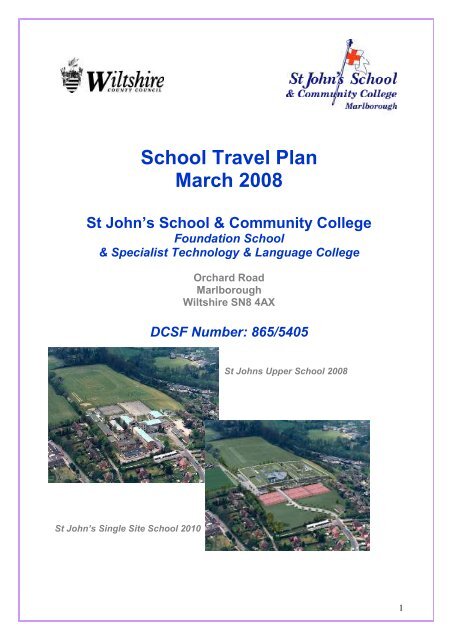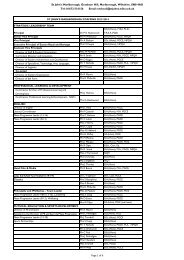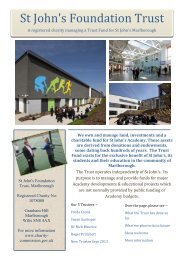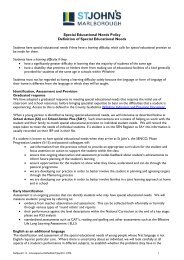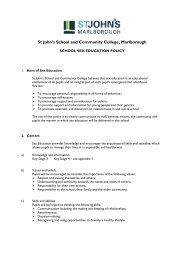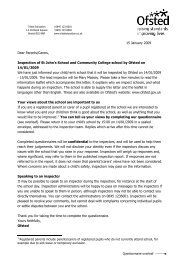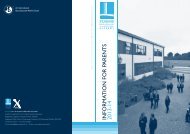Dance 'O' Clock - St John's School and Community College
Dance 'O' Clock - St John's School and Community College
Dance 'O' Clock - St John's School and Community College
Create successful ePaper yourself
Turn your PDF publications into a flip-book with our unique Google optimized e-Paper software.
<strong>School</strong> Travel PlanMarch 2008<strong>St</strong> John’s <strong>School</strong> & <strong>Community</strong> <strong>College</strong>Foundation <strong>School</strong>& Specialist Technology & Language <strong>College</strong>Orchard RoadMarlboroughWiltshire SN8 4AXDCSF Number: 865/5405<strong>St</strong> Johns Upper <strong>School</strong> 2008Version 1.0 February 200<strong>St</strong> John’s Single Site <strong>School</strong> 20101
Contents1. Foreword 31.1 Background to <strong>School</strong> Travel Plans1.2 Why we want a <strong>School</strong> Travel Plan2. Introduction 52.1 <strong>School</strong> background2.2 Our <strong>School</strong>2.3 <strong>School</strong> Travel Plan working group2.4 Associated projects2.6 Existing policies2.6 Future developments3. Survey Results 174. Current Problems 265. Objectives, Targets & Actions 296. Evidence of Consultation 386.1 Pupils6.2 Parents <strong>and</strong> carers6.3 <strong>St</strong>aff6.4 Governors6.5 Wider consultation7. Proposals for monitoring <strong>and</strong> review 418. Proof of ownership <strong>and</strong> sustainability 449. Signatures of endorsement 45Appendices2
1. Foreword1.1 Background to <strong>School</strong> Travel PlansThe Government through its ‘Travelling to <strong>School</strong> Initiative’ wants to see all schoolswith a Travel Plan by March 2010, by bringing a step change in home-to-school travelpatterns to cut congestion <strong>and</strong> pollution <strong>and</strong> also allowing many more pupils to takeregular exercise.<strong>School</strong> Travel Plans show how a school community intends to play its part in reducingunnecessary car travel for the school journey <strong>and</strong> promote more sustainable <strong>and</strong>healthy travel.The <strong>School</strong> Travel Plan can set out measures:• to reduce the number of car trips made to <strong>and</strong> from school, minimising congestionassociated with “the school run”.• to promote the use of healthier <strong>and</strong> more environmentally friendly forms oftransport following concerns over student health <strong>and</strong> lack of exercise.• to improve safety during the journey to school <strong>and</strong> give children an opportunity togain important road sense <strong>and</strong> independence.1.2 Why we want a <strong>School</strong> Travel Plan<strong>St</strong> John’s <strong>School</strong> & <strong>Community</strong> <strong>College</strong> in Marlborough has identified a need for aTravel Plan which will enable the school to support students <strong>and</strong> staff to travel in ahealthy, sustainable <strong>and</strong> safe way on their school journeys.The school is currently based on two sites, which causes specific problems for bothstaff <strong>and</strong> students who are required to commute between the two sites, a returnjourney of 2.4 miles.The school is about to commence construction of a new single-site school, with aseparate new access road. The travel plan enables the school to maximize theopportunities presented by the new school for safe, healthy <strong>and</strong> sustainable travel to<strong>and</strong> from school.The aims of the <strong>St</strong> John’s Travel Plan are:• To identify the key factors that impede students from switching to moresustainable <strong>and</strong> healthy modes of transport.• To investigate realistic solutions for the current split site situation, which includesthe aspect of commuting between sites <strong>and</strong> the anticipated new single site.• To ensure that the new single-site school is seen as a model of good practice inencouraging safe, healthy <strong>and</strong> sustainable travel to <strong>and</strong> from school for bothstudents <strong>and</strong> staff• To engender a sense of responsibility in all members of the school communitytowards their own safety <strong>and</strong> the safety of others on the school journey• To improve safety for pedestrians <strong>and</strong> cyclists on their journey to school,encouraging sustainable travel as an alternative to car travel <strong>and</strong> promotingstudent <strong>and</strong> staff health <strong>and</strong> fitness• To promote safe <strong>and</strong> considerate driving <strong>and</strong> parking for those who have to travelby car3
2. Introduction2.1 <strong>School</strong> Background<strong>St</strong> John’s <strong>School</strong> & <strong>Community</strong> <strong>College</strong> is an 11-18 Technology & Languages collegewith 1,476 students based in the market town of Marlborough. The catchment area ofthe school includes twelve primary schools covering a principally rural area of over250 square miles, <strong>and</strong> largely coterminous with the Marlborough <strong>Community</strong> area.The school is currently based on two sites, which were originally the MarlboroughGrammar <strong>School</strong> <strong>and</strong> Marlborough Secondary Modern, which amalgamated in 1975.The lower school, the Savernake building, is on Chopping Knife Lane, on the easternoutskirts of the town, <strong>and</strong> the Upper <strong>School</strong>, the <strong>St</strong>edman building, is sited to the hill tothe south of the town. <strong>St</strong>udents <strong>and</strong> staff need to commute between sites on a regularbasis.5
The Marlborough <strong>Community</strong> AreaThe catchment area for <strong>St</strong> John’s <strong>School</strong> & <strong>Community</strong> college includes all the parishesshown below. Broad Hinton, Burbage, Grafton <strong>and</strong> Winterbourne Basset send a number ofstudents to <strong>St</strong> John’s even though they are not officially in the catchment area.1. Aldbourne2. Avebury3. Baydon4. Berwick Bassett5. (Broad Hinton)6. (Burbage)7. Buttermere8. Chilton Foliat9. East Kennett10. Froxfield11. Fyfield12. (Grafton)13. Great Bedwyn14. Ham15. Little Bedwyn16. Marlborough17. Mildenhall18. Ogbourne <strong>St</strong> Andrew19. Ogbourne <strong>St</strong> George20. Preshute21. Ramsbury22. Savernake23. Shalbourne24. West Overton25. (Winterbourne Bassett)26. Winterbourne Monkton.<strong>St</strong>.John’sThe catchment is based on the primary school catchment areas for the following schools:Aldbourne <strong>St</strong> Michaels, Baydon <strong>St</strong> Nicholas, Chilton Foliat, Great Bedwyn, Kennet ValleyLockeridge, <strong>St</strong> Peter’s Marlborough, Ogbourne <strong>St</strong> George & <strong>St</strong> Andrew, Preshute Parochial,Ramsbury, Savernake Forest <strong>St</strong> Katherines, Shalbourne. The catchment also includes thearea that was previously the Avebury <strong>School</strong> catchment area, although the school is nowclosed.6
<strong>St</strong> Johns <strong>School</strong> & <strong>Community</strong> <strong>College</strong>Current Sites1: The <strong>St</strong>edman Site, Orchard Road, Marlborough2: The Savenake Site, Chopping Knife Lane, Marlborough7
The new single site schoolThe most significant factor that will affect <strong>St</strong> John’s in the future is the construction ofthe new single-site school building. This will be sited adjacent to the existing <strong>St</strong>edmansite, with a new access road from the Marlborough-Pewsey road. Building work is dueto commence in April 2008 <strong>and</strong> compete in October 2009.An artists impression of the <strong>St</strong> Johns Single Site <strong>School</strong>, due to be completed inOctober 20098
2.2 Our <strong>School</strong><strong>St</strong> John’s is a large rural comprehensive school with around 1500 students, includinga large sixth form of 250 students. The school was described at its last OFSTED as agood school with outst<strong>and</strong>ing features, one of which is our curriculum which will beutilised to ensure the sustainability of this plan.The school became a specialist technology college in 1998, a specialist languagecollege in 2005 <strong>and</strong> an International Baccalaureate World <strong>School</strong> in 2007. Its studentscome from a wide range of backgrounds, reflecting the mixed nature of the area. Veryfew come from minority ethnic groups or do not speak English as their first language,because of the demographic profile of the school’s catchment area. Attainment onentry is just above average. <strong>St</strong>udents are organised into year groups <strong>and</strong> are taught inmainly mixed ability classes at KS3. At KS4 there is more setting on the basis ofability.There are about 20 students with a statement of educational need currently on roll. AllSEN students use public transport, walk, or their parents bring them to school. Wehave no students who use wheelchairs.The architecture of the current sites prevents any students in wheelchairs from fullyaccessing the curriculum; however the new building will be completely accessible. Weplan to begin integration programmes for those children of our community who arecurrently educated elsewhere, who want to join us, immediately the new buildingprogramme commences in 2008.Full TimeTeaching <strong>St</strong>aff 79 31Support <strong>St</strong>aff 27 51Part TimeThe Savernake (Lower <strong>School</strong>) site is open from 7am until 6pm daily in term time forstaff. Lower <strong>School</strong> students are allowed on site daily from 8am (Early Birds club) until5pm (Homework club).The <strong>St</strong>edman (Upper <strong>School</strong>) site is also open from 7am until 6pm daily in term time,for both staff <strong>and</strong> students, <strong>and</strong> the school library at the <strong>St</strong>edman site is open forUpper <strong>School</strong> students from 08:00am until 5:30pm each day.There are sports activities after school for three days a week on both sites whichinclude training <strong>and</strong> matches. In addition to sporting provision for our pupils a numberof extended schools activities take place throughout the year including clubs for art,drama, music, study support, cookery, debating <strong>and</strong> the school play.The school is used as a centre for many primary school sporting festivals. Children<strong>and</strong> parents converge on the school during the school day <strong>and</strong> after school forsporting festivals in rugby, netball, football, cricket, hockey, orienteering, dance,9
athletics <strong>and</strong> tennis. Travel from cluster schools is generally by coach, minibus or car,as the primary schools are spread over a wide area, many in remote rural areas.The two sites are open in the evenings <strong>and</strong> at weekends for a variety of communityuses including• Adult Education• Language Classes• The local concert orchestra <strong>and</strong> choir• Bingo• Badminton• Line dancing• <strong>St</strong>agecoach Drama classes• Air Cadets• Scouts• Local sports clubs using the schools facilities• Ad Hoc bookings from local groups for training meetings, conferences & danceperformances• A rest <strong>St</strong>ation for Various Fund raising events such as sponsored walks for CancerAppeals etc.In the school holidays facilities are used for holiday clubs, including Swindon TownFC.A number of bus services are available for students. Details of these services areincluded in Appendix 4.Parents are not permitted to bring students in cars onto the Lower <strong>School</strong> site, <strong>and</strong> arediscouraged from using the Orchard Road access to the Upper <strong>School</strong> site. Parentsare requested to drop students at a convenient point close to school.Parking on both sites is limited, <strong>and</strong> sited at various locations around the school. Theneed for parking has grown steadily, primarily due to the increase in numbers ofstudents, <strong>and</strong> consequently an increase in staff numbers, on both sites.Parking areas on the two sites for staff, visitors <strong>and</strong> community use are marked on theplans at Appendices 5 & 6.<strong>Community</strong> users will generally come into school by car or on foot. There are notnormally any problems caused by parking requirements as these activities are usuallyoutside school hours when staff parking is not required.10
Access Maps (see over)- see Appendix 3 for A4 versions.The access maps on the following page are the result of a walking & cycling mapexercise conducted in Feb 2008. Each class was shown a projected satellite map ofthe area <strong>and</strong> asked to identify which routes they took to school. The most popularroutes were transferred to the maps.Details of bus stops <strong>and</strong> distances from the school were added to the map by theWiltshire County Council <strong>School</strong> Travel Adviser.The <strong>St</strong>edman site has a single entrance on Orchard Road, to the south of the town. Allvehicles including school buses access the school via Orchard Road, from the A346.Pedestrian access is also from Orchard Road, or via Ducks Meadow & the publicfootpaths which run up the steep hill from George LaneThe Savernake site has only one entrance/exit for all pedestrians <strong>and</strong> vehicles,including school buses, via Chopping Knife Lane, accessed from the A4 to the East ofthe town. The lane has a footpath on the southern side of the road, <strong>and</strong> students haveto cross the lane to access the school.11
Access Map 1: <strong>St</strong>edman – main walking & cycling routesAccess Map 2: Savernake – main walking & cycling routes12
The Single Site <strong>School</strong>The new single site school will be on the same site as the existing <strong>St</strong>edman building<strong>and</strong> will accommodate 1,500 students (current NOR = 1,476). The intention is toincrease the amount of community use of the building.During construction of the new school, the two existing sites will continue to operate,with some loss of sporting facilities <strong>and</strong> the requirement for students to travel to offsitesporting facilities.It is planned that staff <strong>and</strong> students will move into the new school in October 2009,<strong>and</strong> at this point, the existing buildings will be demolished. New sporting facilities,including tennis courts <strong>and</strong> an all-weather pitch will be built during 2010, in part on thesite of the old <strong>St</strong>edman school.A site plan of the new school is shown below. The new vehicle access road is from thewestern boundary of the school (shown on the left of the plan, below).13
The new single site school will be accessed from a new road that is currently underconstruction, running from the A345 at Granham Hill (the Marlborough-Pewsey road).This will be the entrance for all school buses <strong>and</strong> staff /parent/sixth-form cars, with theexception of delivery <strong>and</strong> emergency vehicles which will use the service entrance onOrchard Road (currently the main entrance to the school).Pedestrians <strong>and</strong> cyclists will continue to access the school via Orchard Road or fromthe footpaths leading up the hill from George Lane.Parking at the new school will be in 163 marked bays olong the main access road, <strong>and</strong>there will be 13 coach parking bays.A further 5 disabled parking bays will be available adjacent to the main entrance to theschool.Parking bays are markid in red on the plan at Appendix 7.Marlborough does not have a railway station. Public bus services <strong>and</strong> school buseslink Marlborough with outlying towns <strong>and</strong> villages.At present there are limited facilities for cyclists <strong>and</strong> pedestrians, in the form of opencycle racks <strong>and</strong> some locker facilities.14
2.3 <strong>School</strong> Travel Plan working groups<strong>School</strong> Travel Plan <strong>St</strong>eering GroupThe first formal meeting of this group is Monday Feb 25 1:30 Conference room<strong>St</strong>edman Building. Members of the steering group include:Toni Brodie (Assistant Headteacher AEN)Kate Hunter (<strong>School</strong> Development Officer)Kim Lydon <strong>St</strong>rutt (Governor)Mrs J Reid (parent)The purpose of this group is to monitor <strong>and</strong> evaluate the effectiveness of the STP.<strong>St</strong>udent Travel groupsSustainable Transport Group- Sub group of the Healthy <strong>School</strong> CommitteeThis group was set up in February 08 to examine how improvements to school travelwill benefit the overall health <strong>and</strong> well-being of students.Helen Rodwell (Healthy <strong>School</strong>s Coordinator)Year 7Emily Orkl<strong>and</strong> Hannah Goodall Neelan Kahn Damion KingsleyHugo Gardner Elliot Herod-Taylor Emma Whitworth Claire JamesYear 8Charlotte Farrow Jess Darkens Tom GaleKathryn Denning Anna James Sam WheelerYear 9Andrew Butler Rory Watson Ayesha Holl<strong>and</strong>Fiona MckenzieYear 10Hannah Partis Ellie Blackwell Loran HastingsYear 11Jess PhippardNikki OramThis group are concerned with encouraging students to walk or cycle to school, ratherthan use a car. They have surveyed both school sites to find out about the currentfacilities <strong>and</strong> are developing a plan to encourage more healthy ways of coming toschool. <strong>St</strong>udent presentations from this group relating to sustainable transport areattached at Appendix 1.15
Savernake Transport Group. (years 7-9)Toni Brodie (Assistant Head Teacher)Robert DaubenyBenLuke LightowlerMichael BrigstockThis group was set up in December 07, in response to the concerns raised by theschool community with respect to buses. The focus of the group is to improve theexperience of students whilst they travel to <strong>and</strong> from school by bus. They work closelywith Paul <strong>St</strong>ratford <strong>and</strong> Belinda Wichard (The Wiltshire transport Support <strong>and</strong> TrainingTeam ) <strong>and</strong> meet with them three times a year to discuss issues around studenttransport by bus. The powerpoints this group made to communicate possible solutionsare included as an appendix to this document.2.4 Associated projectsThe school is currently working towards the Healthy <strong>School</strong> Award, of which work onthe <strong>School</strong> Travel Plan is an integral part. Minutes of the first Healthy <strong>School</strong>s councilmeeting are attached at Appendix 2. The aim of the council is to achieve a Healthy<strong>School</strong>s Award <strong>and</strong> will incorporate the need for regular healthy exercise, includingencouraging students to walk or cycle to school.We are also working towards our Eco-<strong>School</strong>s status.2.5 Existing policiesAs a school we promote the Wiltshire Code for Behaviour on <strong>School</strong> Buses, this isattached as an appendix. This was launched to students in September 2007 <strong>and</strong> isregularly promoted through school assemblies <strong>and</strong> at parent’s evenings.2.6 Future developmentsAs outlined in 2.1, the most significant development is the new single-site school.Building work is due to commence in April 2008 <strong>and</strong> complete in October 2009.The key changes that will affect travel to school are:• All students <strong>and</strong> staff will be based on one site, eliminating the need for travelbetween the two sites during the day• The new access road from the A345 Marlborough-Pewsey road will reduce trafficcongestion at several key points that currently cause problems.• The new school will continue to be accessible on foot from the town16
3. Survey ResultsThis is a summary of the results of the student, parent <strong>and</strong> staff surveys. Thefull analysis of the surveys, which was provided by Wiltshire County Council,is attached as an appendix.3.1 <strong>St</strong>udent SurveyHistoric data2001 average of survey data2007 pupil survey dataMode Of Travel 2001 2007Walk 28% 23%Cycle 5% 3%<strong>School</strong> Bus 56% 40%<strong>School</strong> Taxi 2%Public Bus 17%Bus (type unknown) 1%TrainCar / Van 10% 12%Car Share 3%Other 1%Comparing the recent survey data to 2001, the most significant facts relatingto student travel are:• A similar level of students are travelling by bus (58% v 56%)• There has been a decrease in the proportion of students walking orcycling to school (26% in 2007 compared to 33% in 2001)• There has been an increase in the proportion of students travelling by car17% currently travel by car, taxi, or car share, compared to 10% using acar in 2001.17
<strong>St</strong>udent travel distancesFrom 2007 <strong>School</strong> Census. Includes all students postcode dispersal.Distance from<strong>School</strong> (miles)Number ofChildren% of <strong>School</strong>Less than 0.5 170 11%0.5 to 0.99 284 19%1.0 to 1.49 55 4%1.5 to 1.99 34 2%2.0 to 2.99 60 4%3.0 to 5.00 144 10%Over 5.0 745 50%Total number ofchildren 1492 100%The school has a large catchment area of over 250 square miles.Consequently 50% of students live over five miles from their main school site(either the upper or lower school). A further 30% live less than one mile fromschool. 11% live within half a mile of school.The map below was produced from the student survey data <strong>and</strong> shows thespread of students travelling from within a three-mile radius, <strong>and</strong> shows thespread of students throughout the town <strong>and</strong> into the immediate villages.18
Parent Survey March 2007. Sample n=529.The two maps on this page show the findings from the parental survey inMarch 2007, indicating current student modes of travel <strong>and</strong> distancestravelled, firstly for students based at the <strong>St</strong>edman site <strong>and</strong> secondly for theSavernake site. Further detail is available in appendix 11.19
Preferred mode of travel<strong>St</strong> Johns student survey December 2007Mode of travel No. Current Mode (%) No. Preferred mode(%)Walk 231 23% 194 27%Cycle 30 3% 158 22%<strong>School</strong> bus/other 590 59% 199 28%bus/ taxiCar / Van 118 12% 85 12%Car Share 33 3% 22 3%Other (inc. train) 0 0% 52 2%TOTAL 1002 100% 710 100%70%60%59%50%40%30%20%10%0%27%23%3%22%28%Walk Cycle <strong>School</strong> orother bus/ taxi12% 12%3%3%0%2%Car / Van Car Share Other (inc.train)Current Mode (%) Preferred mode (%)Almost 60% of students currently travel to school by bus (either school bus orpublic bus) or by taxi (taxis are provided for some students who live in someof the more remote rural areas).The most significant difference between student’s actual mode of travel <strong>and</strong>their preference is that almost half of students (49%) say they would like towalk or cycle to school, compared to the 26% who actually do.The proportion of students who would prefer to travel by bus is 28%,compared to 59% who do.20
The comments given by students to explain these findings highlight someinteresting results.<strong>St</strong>udents that do not walk or cycle currently give their main reasons as:Lack of cycle pathsDangerous roadsLack of wet weather storage facilities in schoolLack of cycle racksWalking past other students who are smokingBuses were seen as an unpopular method of travel by a significant proportionof students. Their reasons included:Unreliability of busesLengthy routes through numerous villagesOvercrowded busesBullying on busesNo travel passes available for sixth form students3.2 Parent SurveyMeans of travel to schoolParents were asked how their children travel to school. The questionnaire wassent to all parents <strong>and</strong> responses were received from 529 parents of which248 answered the question relating to how their children currently travel toschool.A summary is tabled below.Mode of Parent Response <strong>St</strong>udent Response DifferencetravelBus 60% 58% 2%Walk 30% 23% 7%Car 8% 17% -9%Cycle 1% 3% -2%Results were broadly comparable with the student survey, although parentswere more likely to claim their children walk to school (30% v 23% ofstudents), <strong>and</strong> fewer parents claimed their children are driven to school (8% v17%).21
<strong>School</strong> Journey Danger pointsParents were asked to describe what they felt to be the danger points on theirchild’s journey to school.The main areas were:Buses:Traffic problems on George Lane (where a number of buses drop students)The lack of seatbelts on busesOvercrowded buses leading to students st<strong>and</strong>ingPoor/inconsiderate driving by bus driversBikesDangerous roadsLack of cycle pathsDifficulty carrying kitLack of lockers for storageWalkingLack of formal crossings on routes in townDangerous crossing pointsSpeeding traffic on narrow roadsBusy roadsOtherThe lack of safe crossing points near the bus stops in in outlying villages washighlightedImproving SafetyParents were asked what they felt would improve safety on the schooljourney. The main responses were:BusesTackling poor behaviour/ bullying on busesUsing buses with seat beltsUsing more buses, or double-decker buses on the more overcrowded routesBikesBetter/safer cycle routesWalkingMore formal crossingsSafer crossingsImproving the footpathsBetter gritting of hilly paths on icy daysReduce bullying22
3.3 <strong>St</strong>aff SurveyOf 188 staff at school, 157 responded to the questionnaire.The questionnaire (see Appendix 9c(i)) gathered information regarding theusual method of travel to <strong>and</strong> from school, <strong>and</strong> staffs preferred method oftravel.Because of the move to a single site in October 2009 members of staff werealso asked how they plan to travel to the new school, <strong>and</strong> how they wouldprefer to travel if they were able to.Additionally staff were asked how they normally commute between the twoschool sites.The majority of staff travel to school by car, from a very wide area around theschool. Even those members of staff living within 1 mile of school tend todrive.The map below demonstrates the dispersal of staff over a 20+ mile radius ofthe school, based on the Jan ’08 staff survey.23
Travel to <strong>and</strong> from schoolJan 2008(based on staff survey data for current mode of travel to school)Current modeof TravelPreferredmode ofTravelDifferenceCar 93% 37% -56%Car Share 3% 21% +18%<strong>School</strong> bus/1% 11% +10%other busCycle 0% 12% +12%Walk 3% 14% +9%Other 1% 4% +3%93% of staff members currently travel to school by car. The majority wouldprefer to use a more sustainable mode of transport, whether car sharing, bustravel, cycling or walking.The main reason given for car travel is the need for staff to commute betweenthe two school sites, often several times a day. The two sites are over a mileapart, <strong>and</strong> staff need to carry all their lesson equipment with them.Travel between upper & lower school sitesThe staff who responded to this question gave the following answers:Current mode ofTravelPreferred modeof TravelDifferenceCar 70% 25% -45%Car Share 6% 28% +22%<strong>School</strong> bus/other bus1% 14% +13%Cycle 0% 6% +6%Walk 0% 6% +6%Other 0% 0% 0%Many staff say they would be happy to car share, bus, cycle or walk, but thisis currently impractical because of split-site teaching <strong>and</strong> the lack of a singleteacher “base” where paperwork <strong>and</strong> equipment can be stored.24
Other options suggested to improve school travel for staff include:A better bus serviceA minibus service for staffBetter cycle routesA car share schemeChanging facilities<strong>St</strong>orage facilities, so less to carryCheaper housing in MarlboroughThe new single-site school will eliminate the problems associated withcommuting between two sites, when it opens in October 2009. The school willinclude specific subject teaching areas, <strong>and</strong> staff will have their ownclassroom base, which will include storage facilities.Anticipated <strong>St</strong>aff travel when the single site school is operationalCurrenttravelLikelytravel tosingle sitePreferredtravel tosingle siteDifferencefromcurrentCar 93% 71% 32% -61%Car Share 3% 6% 24% +21%<strong>School</strong> bus/1% 2% 9% +8%other busCycle 0% 1% 11% +11%Walk 3% 8% 13% +10%Other 1% 1% 3% +2%Results demonstrate the positive effect the single site school will have ontravel. The survey shows that the single site alone will reduce the proportionof staff driving to school from 93% to 71%. If some or all of the improvementslisted above are successfully implemented, to allow more staff to use theirpreferred method of travel, the proportion of staff driving to school alone coulddrop to just 32%, with 24% preferring to car share <strong>and</strong> 24% to walk or cycle.With the current two schoolsites, using a car to commute isseen as essential by themajority of staff.Left: A typical member of staffuses their car as their office,<strong>and</strong> the only means to transportheavy loads between sites.25
4. Current ProblemsThrough consultation with key stakeholders, we have identified a number ofkey transport issues/problems. The table below outlines the issues, <strong>and</strong>proposes the initial solution. Solutions in blue are those which will beconsidered as part of the development of the new single-site school due toopen in October 2009.Current travel <strong>and</strong>transport issues/problems<strong>St</strong>udent Issues1: WalkingLimited formal <strong>and</strong> informalcrossing points on schooljourneySpeeding traffic<strong>St</strong>eep hill at <strong>St</strong>edman leadsto problems on icy daysLack of wet weather storagefaciltiesLack of general storagefacilities means studentsneed to carry all theirbelongings to <strong>and</strong> fromschool each day2: CyclingDangerous roadsLack of cycle pathsHow & whenwas thisidentified?Parent survey,<strong>St</strong>udent surveyParent survey,<strong>St</strong>udent surveyParent survey,<strong>St</strong>udent surveyParent survey,<strong>St</strong>udent surveyParent survey,<strong>St</strong>udent surveyParent survey,<strong>St</strong>udent surveyParent survey,<strong>St</strong>udent surveyPossible/suggestedsolutions as suggestedby working groupsDiscuss options forimproved formal <strong>and</strong>informal crossings at keypoints on the schooljourney. Please see PowerpointNew school site: workingparty to establish anylikely changes inpedestrian routes toschool, <strong>and</strong> ensureroutes are safeRoad safety awarenesstraining for Yr 6 & 7students as part of theirinductionInvestigate improvementsto footpath access, <strong>and</strong>gritting on icy daysInvestigate secure wetweather storage for coatsetcSchedule purchase oflocker facilities for allstudentsBikeability training for Yr 6& 7 studentsInvestigate safe cycleroutes, including routesfrom outlying villages26
Lack of general storagefacilities means studentsneed to carry all theirbelongings to <strong>and</strong> fromschool each dayLack of covered cycle racksLack of storage for cyclehelmets etc3: Bus travelTraffic congestion at somedrop-off points causesconcern re. student safetyLengthy bus routes betweenvillages mean long journeysParent survey,<strong>St</strong>udent surveyParent survey,<strong>St</strong>udent surveyParent survey,<strong>St</strong>udent surveyParent survey<strong>St</strong>udent surveyNew school site:investigate includingcycle lane on new accessroadNew school site: workingparty to examinechanges in cycle routesto schoolSchedule in purchase oflocker facilities for allstudentsEstablish numbers ofstudents wishing to cycle toschool & provide adequatefacilitiesNew <strong>School</strong> site: Ensureadequate covered cyclerack facilities are in placeSchedule in purchase oflocker facilities for allstudentsRoad safety training forKS3New school site: includea formal area for buseswhich will maximisesafety for studentsInvestigate scope ofproblem <strong>and</strong> possiblesolutionsUnreliable buses <strong>St</strong>udent survey Investigate scope ofproblem <strong>and</strong> possiblesolutionsOvercrowded buses Parent survey Investigate scope ofproblem <strong>and</strong> possiblesolutionsLack of seatbelts on buses Parent survey Investigate scope ofproblem <strong>and</strong> possiblesolutionsCost of bus travel for 6 thform<strong>St</strong>udent surveyInvestigate scope ofproblem <strong>and</strong> possiblesolutionsBullying on buses <strong>St</strong>udent survey Investigate scope ofproblem <strong>and</strong> possiblesolutions27
<strong>St</strong>aff Travel1: Car travelRegular commutingbetween upper <strong>and</strong> lowerschools during the dayLack of changing facilitiesfor cyclists<strong>St</strong>aff survey<strong>St</strong>aff surveyInvestigate car sharingscheme/ minibus transportfor staff between sitesNew school site: willeliminate need tocommuteInvestigate options for staffshowering/changingNew school site: ensurestaff facilities areadequate to encouragesustainable travel28
5. Objectives, Targets & Action PlanThe following objectives, targets <strong>and</strong> actions have been set using thefindings from the surveys <strong>and</strong> consultation that has been undertaken todate. Any SMART targets have taken into account the preference dataestablished by the surveys.Each action within the plan is set out under 7 headings:ActionThis describes the action point that has been agreed by the workinggroup.How will it be achieved?Indicates the tasks required to complete the action point.Person responsibleThis provides a named person who is responsible for completing theaction point. Where possible, a variety of people should be givenresponsibilities for different action points within the plan, includingmembers of the schools council; this helps ensure the longevity of theTravel Plan.Parties involvedThis lists the people that will be involved / affected by the action point –further consultation with these people may be required to achieve asatisfactory outcome.Timescale / completion dateThis gives a proposed date for the completion of the action. It alsohelps establish whether an action has been completed whenmonitoring the plan.FundingThis identifies if there is a cost element to the action. It may alsoidentify where the money comes from, if currently available, or whetherexternal funding needs to be sourced.Evaluation / ReviewThis column is to help with the monitoring of each action. The progresscan be updated throughout the year – not only does this help keep thetravel plan current but it also reduces the work required when the travelplan needs updating.29
Existing Split-Site <strong>School</strong> Objectives:Objective 1: Increase sustainable travel by students from now to the opening of the new <strong>School</strong> (October 2009)Target: Short-term (to Oct ’09)- increase the proportion of students walking or cycling from 26% to 30% (based onstudent survey 2007)Person responsible for monitoring the objective to make sure actions are carried out: Toni Brodie, Assistant Headteacher,AEN (TAB)No. Action How will it beachieved?1 Increase level of storagefacilities on both upper &lower sites2 Improve off-site pedestrianaccess to <strong>St</strong>edman site3 Cycle Safety trainingInvestigate setting upBikeability training viaRSU, with Level 2 forcluster schools & level 3for Yr 7 students4 Increase amount of cycleracks/ equipment storageavailable5 Build into the curriculumyear 7 <strong>and</strong> Access work onsustainable travelEstablish sources offunding for studentlockersLobby for gritting of icypaths. Initiatediscussions with WCCArea Divisional HighwayManager (Peter Hanson)Ongoing programme ofcycle training forinterested Yr6/7, inconjunction with feederschoolsInvestigate sources offundingWorking with students toresearch their ownconceptions ofSustainable Transport<strong>and</strong> from this to changetheir own practice <strong>and</strong>influence others.PersonresponsibleHelen RodwellHelen RodwellHelen RodwellRSU – BikeabilityinstructorHelen RodwellYear 7 KathPollardAccess CharliePaulPartiesinvolvedHealthy<strong>School</strong>sgroupWCCHealthy<strong>School</strong>sGroupHealthy<strong>School</strong>sgroupHealthy<strong>School</strong>sgroupTeachers<strong>and</strong>studentsTimescale /completiondateTerm 2 2008-09FundingPTS/WCCCapitalGrantEvaluation/ ReviewTerm 4 08-09 WCC Review Oct08Term 6 07-08Term 1 08-09Term 4 08-09Year 7 term 408Access Term4 09PrimaryLiaisonfundCTCgrantCapitalgrant/otherfundraisingschemesReview Oct0830
Existing Split-Site <strong>School</strong> Objectives:Objective 2: Decrease car travel by staffTarget: Short-term (to Oct ’09)- Decrease the proportion of staff driving alone 93% to 88% (based on survey Jan 2008)Person responsible for monitoring the objective to make sure actions are carried out: TABNo. Action How will it beachieved?1 Set up car share schemefor commuting betweenUpper & Lower schoolsitesWorking party toconsult with staff.<strong>St</strong>aff committee toset up formal schemePersonresponsibleVal BallPartiesinvolved<strong>St</strong>aff- RoomCommittee(representatives of stafffrom all areasof the school)Timescale /completiondateFunding Evaluation /ReviewTerm 1 08-09 - October 2008 &Six-monthlyreview thereafter2 Set up car share schemefor staff commuting fromhomeWorking party toconsult with staff<strong>St</strong>aff committee toset up formal scheme4 <strong>St</strong>aff changing facilities Highlight those thatare already availableVal BallGeorgeWorby<strong>St</strong>aff- RoomCommittee<strong>St</strong>aff- RoomCommitteeTerm 2 09-10 October 2008 &Six-monthlyreview thereafterTerm 4 07-08 Oct 08 Assessawareness offacilities4 Low cost cycle purchaseschemeSet up schoolscheme for staff taxfreecycle purchasewith external partnerVal Ball<strong>St</strong>aff- RoomCommitteeTerm 5 07-08 May 08.Promotescheme &monitor take-upon an annualbasis31
Existing Split-Site <strong>School</strong> Objectives:Objective 3: Increase pedestrian safetyTarget: Increase parent satisfaction with student safety (based on parent survey March 2007)Person responsible for monitoring the objective to make sure actions are carried out: TABNo. Action How will it beachieved?1 Improve safety of mainwalking routes fromresidential areas onMarlborough2 Raise awareness of roadsafety issues3 Road safety weekpromotionDiscussion with WCCre safer crossings.Applications forexternal works at keyjunctions.Liaise with <strong>St</strong> PetersJunior school reWCC feasibility studyfor safe crossingsEstablish programmefor Yr 6 & 7, inconjunction withcluster primaryschoolsThrough <strong>St</strong>udentgroupshttp://www.roadsafetyweek.orgPersonresponsiblePartiesinvolvedTimescale /completiondateKate Hunter WCC Term 5 07-08to Term 6 08-09Lucy BennettTABPrimary<strong>School</strong>s<strong>St</strong>udentTransportGroupSeek advicefrom RoadSafety Unit<strong>St</strong>udentTransportGroupTerm 6- 07-08Term 1 08-0910-16 Nov2008FundingTAOSJCNovember2008Evaluation / ReviewTermly review from May08Monitor levels ofawareness of issuesannually32
Existing Split-Site <strong>School</strong> Objectives:Objective 4: Improve bus servicesTarget: Increase level of student satisfaction with bus services (based on student survey 2007)Person responsible for monitoring the objective to make sure actions are carried out: TABNo. Action How will it beachieved?1 Combat any bullying onschool buses2 Ensure safe drop-off & pickup in villages3 Ensure road safety atschool drop-off/pick-uppoints4 Improve communicationbetween students/parents& bus companiesSurvey bus userviews.Regular Monitoring.Address issuesimmediately theyarise. Meet termlyDetermine scope ofproblem & potentialsolutions throughconsultation withparents. Initiatediscussions with buscompanies.Increase trafficawarenessInitiate discussionswith bus companiesre providinginformation linePersonresponsibleTABHFBarry WorthHFParties involvedWiltshire transportSupport <strong>and</strong> TrainingTeamAnn Marr /ShonaYoung/ <strong>St</strong>udentTransport GroupWiltshire transportSupport <strong>and</strong>Training Team<strong>St</strong>udent TransportGroup (reps from allyear groups)Wiltshire transportSupport <strong>and</strong>Training/ <strong>St</strong>udentTransport GroupTeamAdrian Full<strong>St</strong>udent TransportGroup(reps from allyear groups)Timescale /completion datePresent toOct 09Commence Term 407-08.CompleteJuly 09Term 4 07-08Term 4 07-08Funding Evaluation /ReviewTAOSGfunding forfeasibilitystudyRepeat surveybiannuallyMay 08 & Annualconsultation withparents33
New Single Site <strong>School</strong> Objectives:Objective 1: Increase sustainable travel by students from October 2009 to November 2010 (based on survey(s) monthyear)Target: Medium-term (from Oct ’09) - increase the proportion of students walking or cycling from 26% (current) to30% in Oct ’09 & 35% by Oct ’10Person responsible for monitoring the objective to make sure actions are carried out: TABNo. Action How will it be achieved? Personresponsible1 Ensure adequate storagefacilities are availableEstablish sources of fundingfor student lockersPartiesinvolvedTimescale /completiondateBarry Worth December2008FundingPTS/WCCEvaluation /Review2 Improve off-site pedestrianaccess to <strong>St</strong>edman siteInvestigate improvingfootpaths to reduce slippingin icy weather/ incorporatecycle path3 Improve cycle access Establish formal cycle pathson key routes to schoolSeek advice from RoadSafety Unit4 Cycle Safety trainingContinue Bikeabilitytraining via RSU, withLevel 2 for cluster schools& level 3 for Yr 7 studentsOngoing programme of cycletraining for Yr 6 & 7, inconjunction with feederschoolsBarry Worth WCC Oct 09 WCCBarry WorthHelenRodwellRSU –Bikeabilityinstructor<strong>St</strong>udentHealthy<strong>School</strong>sGroup<strong>St</strong>udentHealthy<strong>School</strong>sgroupOct 09Plan inTerm6 ‘09 toimplement inAutumn 09CTCgrantReview annually inOctober5 Build into the curriculumyear 7 <strong>and</strong> Access work onsustainable travelWorking with students toresearch their own ideas ofSustainable Transport <strong>and</strong>from this to change their ownpractice <strong>and</strong> influence others.Year 7 KathPollardAccessCharlie PaulTeachers<strong>and</strong>studentsPlan inTerm6 ‘09 toimplement inAutumn 09Review annually inOctober34
New Single Site <strong>School</strong> Objectives:Objective 2: Decrease car travel by staffTarget: Medium-term (from Oct ’09) - proportion of staff driving alone from 93% in Jan 08 to 83% in October 2009 &78% in October ’10 (based on survey Jan 2008)Person responsible for monitoring the objective to make sure actions are carried out: TABNo. Action How will it beachieved?1 Continue to promote carshare scheme for staffcommuting from home tonew single-site schoolLeaflets. Incentives(better parking placesfor car sharers)PersonresponsibleTABPartiesinvolved<strong>St</strong>aff- RoomCommitteeTimescale /completiondateFunding Evaluation / ReviewOct 2009 Repeat staff surveyevery 2 years2 Promote healthy living &encourage walking/cyclingIncentive Schemes (please see TeachersTV clip re secondaryschools project(appendix 11)HelenRodwell<strong>St</strong>udentHealthy<strong>School</strong>sgroupJune 09 &annuallythereafter3 Improve storage facilities Investigate needsEnsure teachingareas include securestorageBarry Worth All Teachers Oct 09 – Dec0935
New Single Site <strong>School</strong> Objectives:Objective 3: Increase pedestrian safety (based on parent survey March 2007)Target: Increase parent satisfaction with student safetyPerson responsible for monitoring the objective to make sure actions are carried out: TABNo. Action How will it beachieved?1 Monitor safety of mainwalking routes fromresidential areas inMarlborough & improve asrequired2 Raise awareness of roadsafety issuesDiscussion with WCCre safer crossings.Applications forexternal works at keyjunctionsEvaluate roadcrossing safety onnew roadContinue programmefor Yr 6 & 7, inconjunction withfeeder schoolsPersonresponsiblePartiesinvolvedTimescale /completiondateKate Hunter WCC November2010Lucy BennettPrimary<strong>School</strong>sOngoingFundingTAOSJCEvaluation / ReviewContinuation of Parentsurvey (biannual). Monitorlevels of satisfaction36
New Single Site <strong>School</strong> Objectives:Objective 4: Improve bus servicesTarget: Increase student satisfaction with bus services (based on student survey 2007)Person responsible for monitoring the objective to make sure actions are carried out: TABNo. Action How will it beachieved?1 Increase bus reliability Feedback given tocompanies aboutreliability <strong>and</strong> reportsmade to WCC2 Provide safe “bus station”at school3 Combat any bullying onschool busesPersonresponsiblePlanning for New Site Barry WorthRegular DailyMonitoring. Addressissues immediatelythey ariseParties involved Timescale /completiondateHelen Farrow Adrian Full Six-monthly,starting Jan2010TABArchitects,ContractorsWiltshire transportSupport <strong>and</strong>Training TeamAnn Marr /ShonaYoung<strong>St</strong>udent TransportGroupFunding Evaluation /ReviewSix-monthlyanalysis offindingsOct 09 TAOSJC Survey studentsinitially everyterm from Oct09- for 1 year,then annuallyOct 09 Daily monitoringby studentmanager.Termlysummaries byTAB37
6. Evidence of ConsultationThroughout the Travel Plan, a variety of people have been consulted to makesure that the views from all key parties have been elicited.6.1 <strong>St</strong>udentsWalking <strong>and</strong> Cycling Map exercise (February 2008).Each class was showna projected satellite map of the local area <strong>and</strong> they were asked to identifywhich routes they took to school. This was then transferred to a paper map.These results maps included pedestrian access points, <strong>and</strong> bus stops. SeeAppendix 3<strong>St</strong>udents Working Parties.( ongoing) Evidence from these consultations areavailable as minutes from the meetings .<strong>School</strong> Council Meetings (Term 4) The <strong>School</strong> Travel plan will be discussedin detail at <strong>School</strong> Council Meetings which are held termly.Curriculum. The highly regarded <strong>St</strong> John’s Curriculum has a unit entitled“Higher Faster <strong>St</strong>ronger”. This unit is being adapted by a group of students toinclude the annual review of the <strong>School</strong> Travel PlanAssemblies. (term 4&5 2007-08). The student working parties have plannedto lead assemblies for all year groups. The views <strong>and</strong> ideas of the studentswill be elicited once more to verify the actions are still valid.This will involve six assemblies, one for each year group.These assemblies will outline the purpose of the plan <strong>and</strong> the results of thesurveys. The students will then explain what the proposed actions are so far<strong>and</strong> explain how students can make their views known:• Suggestion Boxes on each site .• E- mail• Talking to their mentor, parent or teacher• Talking to one of the members of the <strong>School</strong> travel Group, Healthy<strong>School</strong>s travel Sub-group.38
6.2 Parents <strong>and</strong> carersParent Survey (March 07) . results from this questionnaire are attached as anappendix. All the parents who responded in an extended form wereapproached individually to join the <strong>School</strong> Travel Plan <strong>St</strong>eering Group. 529parents responded to the survey.Newsletter (March 08). The results of the survey are to be published in themonthly <strong>School</strong> Newsletter. When the plan’s actions have been verified theywill be published <strong>and</strong> regular updates will be published.Parent’s Meetings From March 17 th (“Meet the mentor Day”) a display will beavailable at each parent’s meeting <strong>and</strong> a member of staff will be available totalk to parents <strong>and</strong> carers about the STP <strong>and</strong> verify with parents <strong>and</strong> carersthe emerging priorities <strong>and</strong> proposed actions.Left: the school travel plan noticeboard is now a permanentdisplay for all students, staff <strong>and</strong>visitors to school to studyParents meetings are held throughout the academic year, with one parentsevening for each year group, as well as an introductory evening for parents ofcurrent Year 6 students.Website From March 08, parents will be able to follow the progress of theSTP through the <strong>School</strong> website.Open meeting. The <strong>School</strong> Newsletter for February invited parents to anopen meeting on 1 st April ‘08. (See Appendix 10) The purpose of this meetingwill be to verify with parents <strong>and</strong> carers the emerging priorities <strong>and</strong> proposedactions.39
6.3 <strong>St</strong>aff<strong>St</strong>aff Survey (Jan 08). An example of this questionnaire is attached as anappendix. All staff who responded in an extended form were approachedindividually to join the <strong>School</strong> Travel Plan <strong>St</strong>eering Group. See Appendix 9c (i)Meetings. (Jan 08) The STP was discussed at a range of meetings for whichthe minutes are available in the appendices, including :• Full <strong>St</strong>aff meetings 09/01/08. See Appendix 9c (iv)• <strong>St</strong>aff briefings. A consultation with staff took place on 13/03/08 wherethe STP was presented <strong>and</strong> questions taken.• Senior Leadership Team, comprising the Headteacher, Deputy Heads,Assistant Heads, Bursar, Deputy Bursar & the Headteacher’s PA. SeeAppendix 9d (i)• Year 7 Curriculum Team6.4 GovernorsMeetings (Term 4/5). The STP will be discussed at a Governors meeting toverify with governors the emerging priorities <strong>and</strong> proposed actions.<strong>St</strong>eering Group initiated 25/02/08. A Governor is on the <strong>St</strong>eering group.6.5 Wider consultationWe have consulted with Maria Wood, <strong>School</strong> Travel Adviser at WiltshireCounty CouncilWe consult with the Wiltshire Passenger Transport Unit <strong>and</strong> <strong>School</strong> Transporton a regular basis. We have consulted them about our plan <strong>and</strong> look forwardto working with them to further the aims of this plan.We will also consult with Road Safety Officers, Traffic Wardens <strong>and</strong><strong>Community</strong> Police, particularly with reference to the transition to the newsingle-site school, when the new access road will be in operation.40
7. Proposals for Monitoring & Review<strong>St</strong>age 1 Do we really need this?ResearchDo we need to do anything?Contact parents/carersCheck with SLT that they agree this needs to be doneCheck again with SLT that they agree to go ahead with the plan, after the researchCreate steering groupShare plan with Headteacher Dr HazlewoodGet a press release done for local paperLetter in school newsletterHealthy <strong>School</strong>s group <strong>and</strong> <strong>School</strong> Transport GroupFind a notice board on each site that can be used to communicate with studentsContact <strong>St</strong>udentsCommunicate progress<strong>St</strong>age 2 What is <strong>St</strong> John’s trying to achieve with this plan?Make calendar of actionsCommunicate this to <strong>St</strong>akeholder groupsDecide on the Big Questions• How can we reduce the number of car trips made to <strong>and</strong> from school?• How can we promote the use of healthier <strong>and</strong> more environmentally friendly forms oftransport?• How can we improve safety during the journey to school <strong>and</strong> give students anopportunity to gain important road sense <strong>and</strong> independence?Meet <strong>St</strong>eering group <strong>and</strong> <strong>St</strong>akeholdergroupsTo answer questions. Research that has taken place will be shared<strong>St</strong>eering group25 th Feb 1:30pm<strong>St</strong>udents – Transport Group12 th Dec L541
<strong>St</strong>udents- Healthy <strong>School</strong>s 8 th Feb L4Travel group<strong>St</strong>age 3 How are we going to achieve our desired outcomes?Draw up plan in the light of answers to Decide how to monitor the effectiveness of the planthe big questions <strong>and</strong> school priorities. SLT 25/02/08<strong>St</strong>eering Group 06/03/08Consult on how to monitor the planGovs 5/03/08<strong>St</strong>age 4 Is our plan right?Validate emerging priorities of the planwith groupsCommunicate plan <strong>and</strong> priorities<strong>St</strong>age 5 How has the plan worked?Monitor effectiveness with <strong>St</strong>eeringGroupCommunicate effectiveness<strong>St</strong>age 3 loop Maintenance of planMeet with <strong>St</strong>akeholder groupsSLT 30/06/08<strong>St</strong>eering group 8/07/08<strong>St</strong>udents03/07/08(L2)Parents<strong>Community</strong>NewsletterWebsiteAssembliesTo feed into next year’s planSLT Term 2 08/09<strong>St</strong>eering group Term 2 08/09<strong>St</strong>udents groups Term 2 08/09<strong>School</strong> NewsletterWebsiteGovsPress release42
Draw up plan in light of priorities frommonitoring , student work done in year 7<strong>and</strong> by the Access group <strong>and</strong> <strong>School</strong>priorities<strong>St</strong>age 4Validate emerging priorities from planwith groups ( new surveys term 4, 2010)Communicate this<strong>St</strong>age 5Monitor effectiveness with <strong>St</strong>eeringGroupCommunicate effectivenessTerm 2 09/10Term 4 09/10Term 2 10/1043
8. Ownership & Sustainability• The <strong>School</strong> Travel Plan is included in the <strong>School</strong> development plan.Our <strong>School</strong> Development plan is organised under four headings.One of which is meeting the Every Child Matters ( ECM) agendaitems. The STP is included in this section under the items <strong>St</strong>ayingSafe <strong>and</strong> Keeping Healthy.• The aims of the STP are to be included in the new <strong>School</strong>Prospectus.• A copy of this proposal is available at both reception sites <strong>and</strong> thereis a notice board dedicated to the STP on the Savernake site.• include it in the curriculum, - The year 7 Alternative Curriculummodule Higher Faster <strong>St</strong>ronger <strong>and</strong> the year 10/11 AccessCurriculum will have an aspect that allows students to consider thequestions:o How can we reduce the number of car trips made to <strong>and</strong> fromschool?o How can we promote the use of healthier <strong>and</strong> moreenvironmentally friendly forms of transport?o How can we improve safety during the journey to school <strong>and</strong>give students an opportunity to gain important road sense <strong>and</strong>independence?• We intend to take part in the Road Safety Week promotions 10-1Nov 2008• We will investigate a car sharing scheme <strong>and</strong> promote this.44


